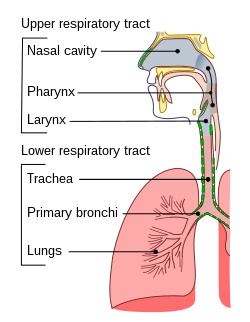
Back سبيل تنفسي Arabic Tənəffüs aparatı Azerbaijani Dýchací cesty Czech Vía aérea (anatomía) Spanish Hingamisteed Estonian Arnasbide Basque راه هوایی Persian Hengitystiet Finnish Voies respiratoires French श्वसन पथ Hindi
| Respiratory tract | |
|---|---|
 Conducting passages | |
| Details | |
| System | Respiratory system |
| Identifiers | |
| FMA | 265130 |
| Anatomical terminology | |
The respiratory tract is the subdivision of the respiratory system involved with the process of conducting air to the alveoli for the purposes of gas exchange in mammals.[1] The respiratory tract is lined with respiratory epithelium as respiratory mucosa.[2]
Air is breathed in through the nose to the nasal cavity, where a layer of nasal mucosa acts as a filter and traps pollutants and other harmful substances found in the air. Next, air moves into the pharynx, a passage that contains the intersection between the oesophagus and the larynx. The opening of the larynx has a special flap of cartilage, the epiglottis, that opens to allow air to pass through but closes to prevent food from moving into the airway.
From the larynx, air moves into the trachea and down to the intersection known as the carina that branches to form the right and left primary (main) bronchi. Each of these bronchi branches into a secondary (lobar) bronchus that branches into tertiary (segmental) bronchi, that branch into smaller airways called bronchioles that eventually connect with tiny specialized structures called alveoli that function in gas exchange.
The lungs which are located in the thoracic cavity, are protected from physical damage by the rib cage. At the base of the lungs is a sheet of skeletal muscle called the diaphragm. The diaphragm separates the lungs from the stomach and intestines. The diaphragm is also the main muscle of respiration involved in breathing, and is controlled by the sympathetic nervous system.
The lungs are encased in a serous membrane that folds in on itself to form the pleurae – a two-layered protective barrier. The inner visceral pleura covers the surface of the lungs, and the outer parietal pleura is attached to the inner surface of the thoracic cavity. The pleurae enclose a cavity called the pleural cavity that contains pleural fluid. This fluid is used to decrease the amount of friction that lungs experience during breathing.
- ^ Patwa A, Shah A (September 2015). "Anatomy and physiology of respiratory system relevant to anaesthesia". Indian Journal of Anaesthesia. 59 (9): 533–541. doi:10.4103/0019-5049.165849. PMC 4613399. PMID 26556911.
- ^ "Respiratory mucosa". mesh..nlm.nih.gov. Retrieved 26 July 2019.